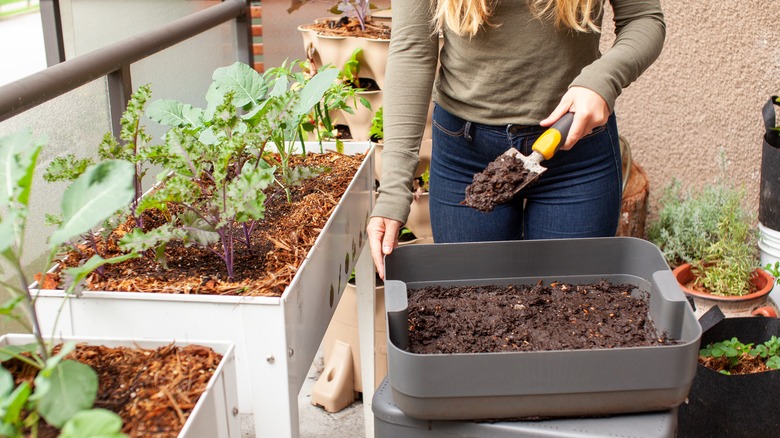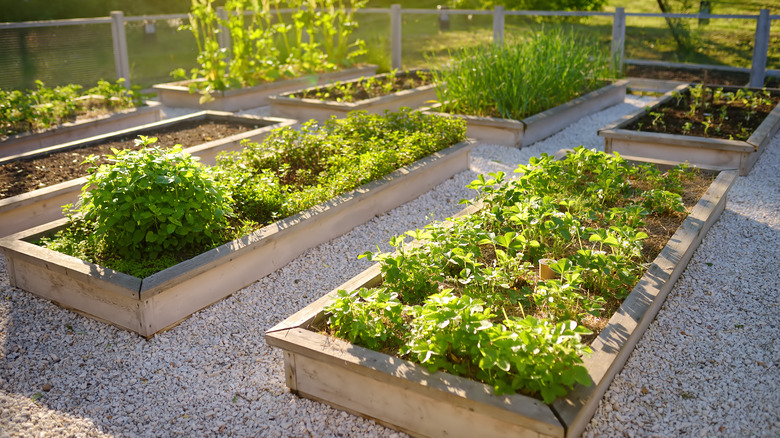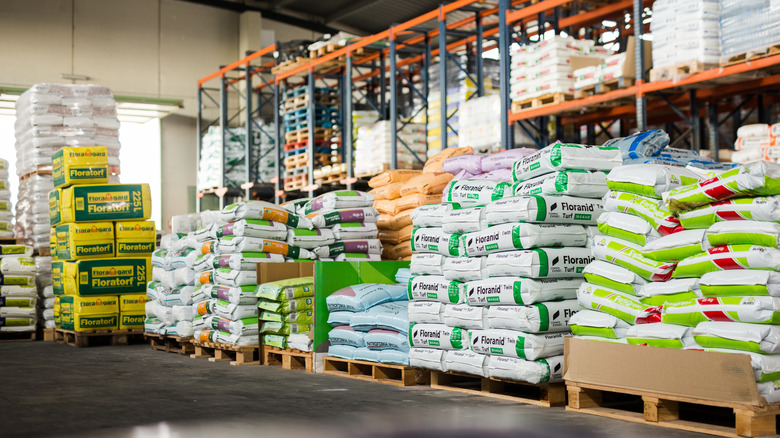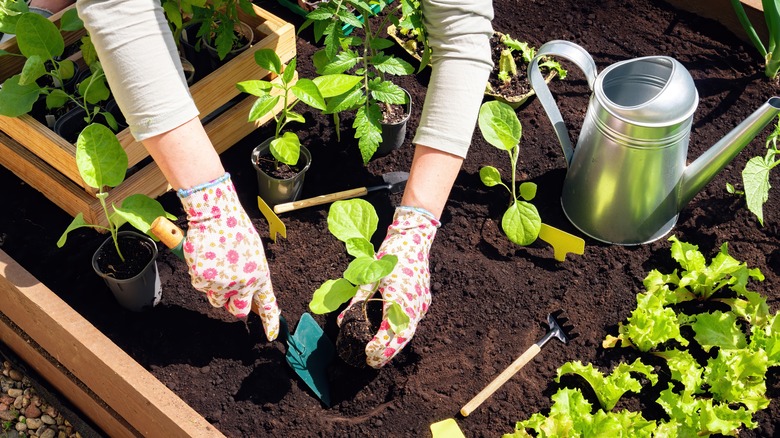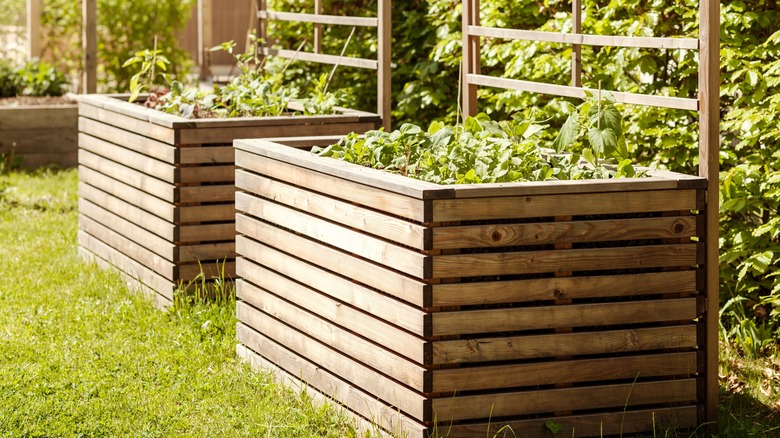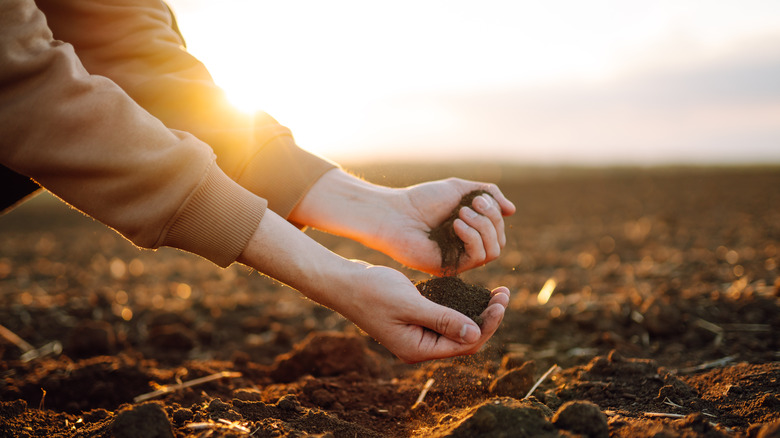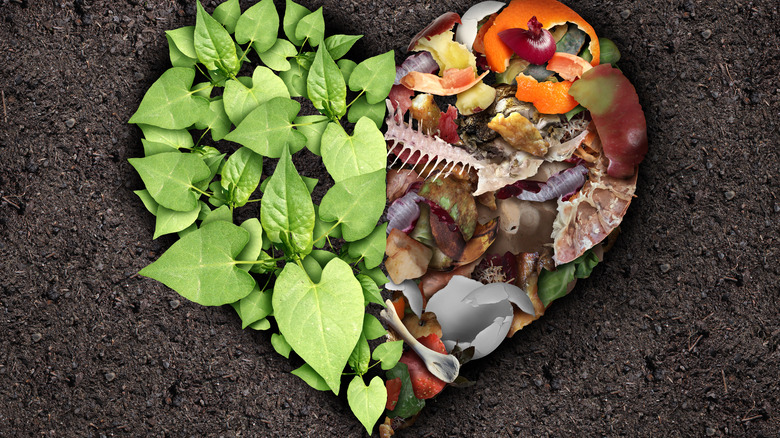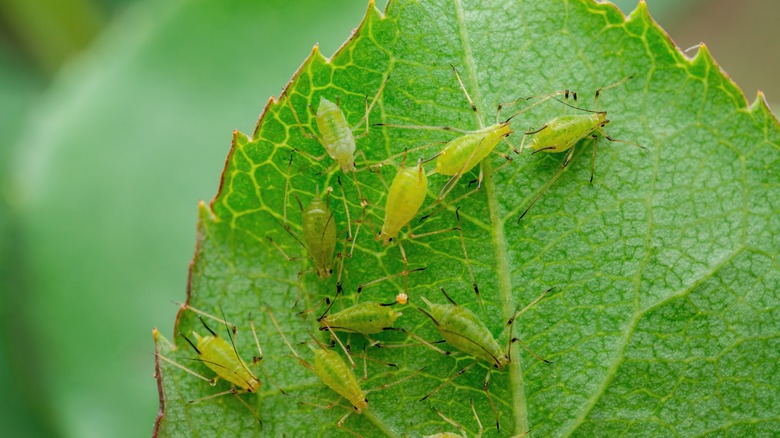The Ultimate Guide To Starting A Raised Bed Garden
Homeowners who love gardening can find immense value in the addition of raised garden beds. Raised garden beds do exactly what they offer: They add height to your ground-level planting. Raised garden beds are great for homeowners with mobility issues, in particular (via Age Space). Bringing your plants a few inches to a few feet off the ground can eliminate much or all of the bending involved in typical garden activities like weeding or harvesting your crops. Yet, the ability to garden without bending down and spending hours hunched over in the dirt isn't the only benefit that a raised garden bed can provide. These garden beds are great for reducing pest issues, minimizing invasive plant growth, and slowing the traction of weed growth, to name a few.
What's more, raised garden beds often look fantastic when laid out with a cohesive plan for designing the new garden space. A homeowner who loves spending time outdoors and growing their own fruits and vegetables may get a lot of mileage out of a well-designed set of raised garden beds. As well, for homeowners who have installed or built greenhouses, using raised garden beds inside this protected area is often a great way to maximize planting space and general layout in these limited growing areas.
Raised garden beds can provide a huge variety of positive aspects to your home gardening approach, but there are some key things to keep in mind when establishing or expanding a garden that makes use of raised beds.
The benefits of a raised garden bed
There are an enormous number of important benefits that a raised garden bed can bring to the table when it comes to home gardener activities. For one thing, the mobility that seniors and others can reclaim by using elevated planting spaces is second to none. There simply is no other alternative that can compete with this aspect of the raised garden bed. Many people have made use of padding and other tools to improve their gardening experience, but these simply do not stack up against a raised bed in the end. In addition to this feature of elevated planting, raised beds are excellent options for those who have pets at home and need a way to keep their dog or cat out of the garden. A raised bed creates a natural barrier between the growing space and any walking room that surrounds the area. Adding a foot or more in elevation to the growing medium can be all that it takes to dissuade a curious pet from climbing into the soil and making a mess of your vegetables and other plants.
In the same way that a raised bed can be beneficial for pet owners, these features are also great for reducing the incidence of pest infestations. Rabbits and insects are often the banes of a gardener's existence. But this additional elevation can make access to your plants harder to come by, thereby slowing the pace with which pests can munch on your growing produce. There are, of course, additional measures that can be taken in tandem with a raised bed, such as the use of chicken wire and other preventative measures. These fit perfectly in with the footprint of a raised garden bed but may be harder to implement in a ground-level planting environment.
Lastly, a set of raised garden beds allows homeowners to worry far less about the consequences of cross-planting invasive species. Mint, for example, is one of the fastest growers that home gardeners bring into their planting areas (via The Herbal Academy). Mint is useful in many different cooking and drink-making applications, but a gardener will always have to be incredibly careful with where they place their mint plants because of the subterranean growth that quickly chokes out all other competitors. With raised garden beds, there is simply no overlap in different growing spaces, and so these types of invasive crops can be contained without incident.
Potential pitfalls of the raised bed design
While a raised garden bed provides many excellent features that make gardening easier and more enjoyable, there are some definite drawbacks to consider as well. For one thing, a raised garden bed is more expensive than one that simply sits at ground level. A structure that will form the bed's outline, and a significant amount of additional soil to bring the planting space up to your desired height are each required to complete this transformation. To get a sense of the soil volume required, you can use a simple formula for volume. This will help you determine how much soil you'll be required to purchase from your local hardware store, and truthfully the amount might be surprising. A simple six-foot by three-foot (and two-foot tall) planter will require 48 bags of soil, or roughly 36 cubic feet, to raise the planting level to the top of the container (via Lowes). This becomes an even greater requirement with additional raised garden beds or larger planting spaces to round out your outdoor planting needs.
The cost of soil is one element to keep in mind when building a raised garden bed, but the containers themselves can be costly especially if you don't build them by hand. Building your own garden beds takes a little bit of effort but it can reduce the overall cost of construction and maintenance for this feature. As well, it's important to consider the layout of your garden space, a garden that's not very big might not benefit a whole lot from the use of raised beds. Raised garden beds reduce the amount of space that you can plant in by adding these exterior walls to the area. While this is typically a positive feature, in an area with limited planting space to begin with, it can be a problem rather than a solution.
With all this being said, installing raised garden beds is typically a great option for just about any kind of home gardener and the use of these installations can really amplify your planting space both aesthetically and functionally.
Building or purchasing garden beds starts with your dimensional requirements
When installing raised garden beds in your yard, it's important to think about the dimensions that are right for you and your needs. Every gardener will have their own specific requirements because every home is different. Not only must you think about the spatial requirements of this design and installation process, but you also need to consider the types of plants you will be growing in your raised beds. Many homeowners look to install raised beds in multiples of two in order to create a sense of symmetry in this garden feature. This means that you'll need to potentially double your budget for materials for prefabricated beds when considering this addition. Simple Family Crazy Life notes that symmetry is often more prevalent in the garden, but odd-shaped or asymmetrical designs can be used to great effect as well.
Fortunately, building your own garden beds is often a very straightforward task. The Royal Horticultural Society suggests using solid timber for this process and carving out small trenches for the area that you'll be using to place these boundaries. Trenching the space before you build your garden beds is great for a number of reasons. First of all, it gives you a visual outline of where your garden beds will be positioned throughout the yard before you begin constructing the features themselves. This acts like a dry run for the building process and can help you hammer out any design flaws that you may encounter along the way. Smoothing over any issues before you begin construction will help make the process of building raised garden beds much easier and will give you a greater level of satisfaction in the fabrication component and planting process later on. Once you've decided on a layout and placed your timber, you'll need to press edges together as tightly as possible. Using a small mallet can help push pieces into their proper positioning in the ground before you fasten the sides together with screws. All that's left to do then is to consider how tall you want your garden beds to be and add an appropriate number of additional layers on top of the foundation elements to account for your desired height.
Designing the layout of your raised beds is critical to success
During the layout process, it's important to think about walking space, the proximity of different features to one another, and having a sense of symmetry in the garden, among other things. Raised garden beds that are installed in your yard quickly become an ingrained feature in the space. This means that positioning them in such a way that fits your planting needs and beautifies the space is crucial. A symmetrical layout for your garden beds will provide a sense of harmony to this planting space that simply can't be found with a more chaotic outline (via Redeem Your Ground). Nature itself incorporates both the sense of proportionality and restrained chaos. Therefore, if your garden beds are placed in a way that seems haphazard or unplanned, the whole area can quickly grow into an unruly mess that makes you think twice about engaging in this pastime. Your layout can spur creativity and immense satisfaction, or it can lead to a retreat from the garden altogether.
Fortunately, the design phase of building your garden beds allows for an immense outpouring of creativity and personalization. You can design these features in any way that you see fit and many homeowners opt for a perimeter layout that allows you to stand in the middle of your planting space or a row option that sees garden beds forming a set of lanes that you can walk through for maximum accessibility. No matter how you choose to design your outline, making your own and ensuring that the space oozes with creativity and peaceful energy is essential.
Add a barrier at the bottom of the garden bed
One of the last things that you'll need to do before planting in raised garden beds is the installation of a barrier at the bottom of this newly built space. Creating this barricade between the ground and the topsoil in your planting medium will help you maximize weed control in each feature. Weeds are an immensely pesky addition to any garden. They can grow out of control and some are highly invasive, eventually choking out the plant matter that you want to grow in certain parts of the garden. Weeding is an important task for any gardener, but much of it can be avoided with the use of a raised garden bed. Adding height to your planting space not only makes it so you don't have to bend down to reach your plants at harvest time or during watering, but it can also be used to great effect when seeking to reduce or eliminate weed growth in the garden.
A barrier at the bottom of your garden bed will effectively smother any plant matter that may be growing underneath the space that you've added garden beds to (via The Grounds Guys). By thoroughly covering the bottom of the bed, you can effectively eradicate much or all of the weeds that exist within these spaces. It should be noted, however, that failing to include a barrier between the two sections of soil simply serves to create a heightened topsoil that interconnects the ground and your new raised garden bed. Simple barriers made from cardboard, newspaper, mesh, or other materials are highly effective at segmenting out these two spaces and allowing your bed to facilitate the growth of only those plants that you want to cultivate.
Consider your soil needs and plan for excess use
As noted previously, purchasing topsoil to build the perfect medium for growth is essential. It can be easy to underestimate the amount of soil you'll require to fill in any new garden bed or set of raised beds in your yard. Calculating the amount of soil required is an important step (via Earth Easy), and it's always advisable to purchase more than you think you'll need. This is because garden soil purchased at a local home improvement shop typically incorporates a healthy blend of the minerals that plants require for active growth. But plants quickly suck these out of the soil and future growth will be stunted if you don't replenish the chemical balance of the growing medium. Additional soil can help round out a longer growing season by giving you the ability to simply add new soil to the top of the bed.
It's also essential to think about soil amendments while building raised garden beds. Fertilizers and natural amendments will help create a healthy and balanced environment in each bed in order to provide key nutrients to all of your plants growing within them. One last feature that new gardeners might fail to take into consideration is the different soil requirements of different types of plants. Some plants may require a potassium-rich environment while others thrive in high nitrogen or acidic soils. Doing your homework and understanding the types of soil amendments that you'll require for ample healthy growth across different target plant varieties will help make your planting experience greener and more successful. Similarly, drainage requirements will differ between varieties of plants and so adding clay, rocks, and other soil additions that go beyond the fertilizer realm will enhance your experience as well.
Make use of composting techniques
Another key feature of a successful home garden is the use of composting techniques. Any type of home gardener can benefit from the addition of a compost bin, but those with raised garden beds simply must incorporate composting practices to create a thriving gardening environment. With the additional soil requirements brought on by raised garden beds, it's simply unfeasible to continuously add bag after bag of soil to the beds with each new planting season. Instead, using a composter will give you access to nutrient-rich soil that can be added on a routine basis to supplement or altogether replace your reliance on purchased topsoil. Composting is as simple as adding equal parts of green and brown material to a space that's conducive to the decomposition of organic matter, according to the University of Connecticut Extension. Compost bins can be highly technical additions to your garden or simple wooden boxes that allow nature to do its thing uninterrupted.
Making compost doesn't have to be difficult, but it does provide a huge benefit to your gardening experience by creating dense, nutrient-rich soil that can be placed directly into your raised garden beds for improved growth over the course of each successive season.
Opt for additional pest control measures if you need them
Raised garden beds are great for reducing pest infestations on their own. By lifting the space off the ground, you eliminate some of the natural ability for insects and rodents to access your plants unimpeded. However, this isn't a comprehensive approach to eliminating contact from pests altogether. A determined animal can still wreak havoc in a raised garden bed, but additional measures can be taken in tandem with the height to make it even harder for pests to gain a foothold in your garden. Using chicken wire or mesh nets around the edges of your raised beds can make it all but impossible for large rodents to find their way into your growing space, according to Joe Gardener. Chicken wire is easy to source, and perhaps even easier to use in the garden. Wrapping this around the edges of your raised beds will go a long way to keeping rabbits and house pets alike out of the soil and away from your plants for good.
Convenience, accessibility, beauty, and increased functionality — there are plenty of reasons to garden in raised beds. With proper planning, a well-thought-out design, and a bit of work, a raised bed garden can become a highlight of your landscape.
